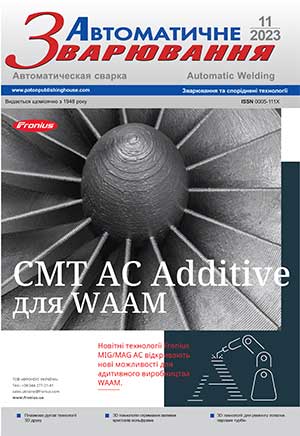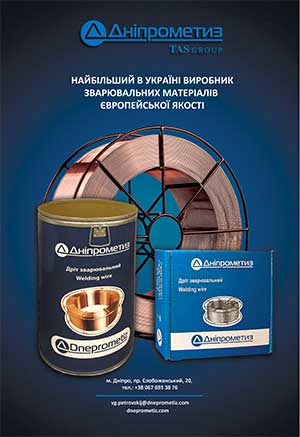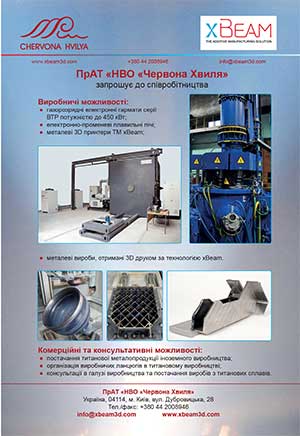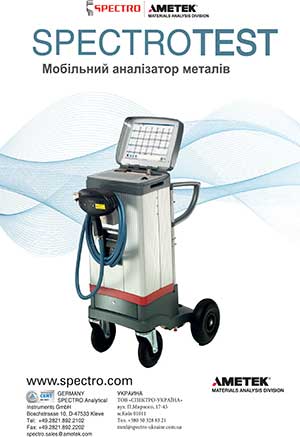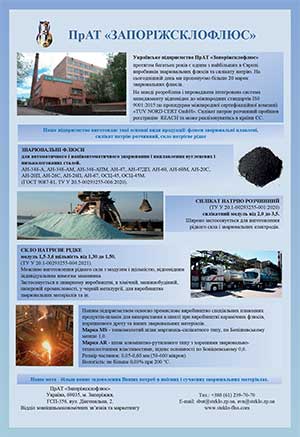| 2023 №11 (01) |
DOI of Article 10.37434/as2023.11.02 |
2023 №11 (03) |
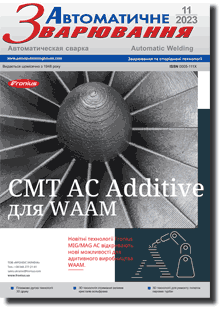
Журнал «Автоматичне зварювання», № 11, 2023, с. 23-31
Вплив методів GMAW і PAW адитивного дугового наплавлення та складу захисного газу на геометричні характеристики поверхонь і структуру металу виробів
В.В. Квасницький, І.М. Лагодзінський
НТУУ «Київський політехнічний інститут імені Ігоря Сікорського». 03056, м. Київ, просп. Берестейський, 37. E-mail: kvas69@ukr.netЗ розвитком WAAM (Wire Arc Additive Manufacturing) технологій постає необхідність забезпечення стабільності характеристик якості просторових виробів та бажано отримати на виході поверхню з найменшою геометричною нерівномірністю. Дугове наплавлення, зокрема з короткими замиканнями (Cold Metal Transfer – CMT), та імпульсно-дуговe наплавлення (Pulse процес) дозволяють підвищити контроль поведінки розплаву зварювальної ванни, зменшити витрати матеріалу на розбризкування та угар, що забезпечує збільшення продуктивності процесу. Разом із цим, актуальними є дослідження щодо закономірностей впливу методів дугового наплавлення, зокрема технологій CMT, Pulse та PAW, і складу захисного газового середовища на геометричні характеристики сформованих шарів, структуру наплавленого металу та схильність до утворення дефектів. Аналіз геометричних характеристик зразків свідчить, що склад захисної газової суміші має суттєвий вплив на висоту наплавлених шарів незалежно від методу наплавлення (CMT/Pulse). Так, для суміші М11 висота окремих валиків збільшується на 10,4…11,7 % у порівнянні з використанням суміші М21. Застосування імпульсного струму призводить до збільшення на 10…11 % ширини валиків у порівнянні з CMT процесом. Металографічні дослідження свідчать про типову для багатошарового наплавлення структуру металу виробів. Чіткої межі між окремими шарами наплавленого металу не виявлено. Бібліогр. 18, табл. 2, рис. 9.
Ключові слова: WAAM, GMAW, Cold Metal Transfer, плазма, адитивні технології, 09Г2С, пошарове наплавлення, захисна газова суміш
Надійшла до редакції 25.10.2023
Список літератури
1. Ding, D., Pan, Z., Cuiuri, D. et al. (2016) Adaptive path planning for wire-feed additive manufacturing using medial axis transformation. J. of Cleaner Production, 133, 942–952. DOI: https://doi.org/10.1016/j.jclepro.2016.06.0362. Rodrigues, T.A., Duarte, V., Miranda, R.M. et al. (2019) Current status and perspectives on wire and arc additive manufacturing (WAAM). Materials, 12(7), 1121. DOI: https://doi. org/10.3390/ma12071121
3. Pan, Z., Ding, D., Wu, B. et al. (2018) Arc welding processes for additive manufacturing: A review. Transactions on Intelligent Welding Manufacturing, 1, 3–24. DOI: https://doi. org/10.1007/978-981-10-5355-9_1
4. DebRoy, T., Wei, H.L, Zuback, J.S. et al. (2018) Additive manufacturing of metallic components – Process, structure and properties. Progress in Materials Science, 92, 112–224. DOI: https://doi.org/10.1016/j.pmatsci.2017.10.001
5. Kvasnytskyi, V., Korzhyk, V., Lahodzinkyi, I. et al. (2020) Creation of volumetric products using additive arc cladding with compact and powder filler materials. IEEE 10th International Conference Nanomaterials: Applications & Properties (NAP), pp. 02SAMA16-1–02SAMA16-5. DOI: https://doi. org/10.1109/NAP51477.2020.9309696
6. Xiong, J., Li, Y., Li, R., Yin, Z. (2018) Influences of process parameters on surface roughness of multi-layer single-pass thin-walled parts in GMAW-based additive manufacturing. J. of Materials Processing Technology, 252, 128–136. DOI: https://doi.org/10.1016/j.jmatprotec.2017.09.020
7. Graf, M., Hälsig, A., Höfer, K. et al. (2018) Thermo-mechanical modelling of wire-arc additive manufacturing (WAAM) of semi-finished products. Metals, 8(12), 1009. DOI: https:// doi.org/10.3390/met8121009
8. Ogino, Y., Asai, S., Hirata, Y. (2018) Numerical simulation of WAAM process by a GMAW weld pool model. Weld World, 62, 393–401. DOI: https://doi.org/10.1007/s40194-018-0556-z
9. Rao, Z.H., Liao, S.M., Tsai, H.L. (2010) Effects of shielding gas compositions on arc plasma and metal transfer in gas metal arc welding. J. of Applied Physics, 107(4), 044902. DOI: https://doi.org/10.1063/1.3291121
10. Gurcik, T., Kovanda, K., Rohan, P. (2019) Influence of shielding gas on geometrical quality of WAAM technology. METAL 2019 – 28th International Conference on Metallurgy and Materials, Conference Proceedings, pp. 715–721. DOI: https://doi.org/10.37904/metal.2019.871
11. Bishal, S., Pudasaini, N., Roy, S. et al. (2022) Altering the supply of shielding gases to fabricate distinct geometry in GMA additive manufacturing. Applied Sciences, 12(7), 3679. DOI: https://doi.org/10.3390/app12073679
12. Mvola, B., Kah, P. (2016) Effects of shielding gas control: welded joint properties in GMAW process optimization. The International J. of Advanced Manufacturing Technology, 88(9-12), 2369–2387. DOI: https://doi.org/10.1007/s00170-016-8936-2
13. Gouda, M., Takahashi, M., Ikeuchi, K. (2005) Microstructures of gas metal arc weld metal of 950 MPa class steel. Science and Technology of Welding and Joining, 10(3), 369– 377. DOI: https://doi.org/10.1179/174329305X40714
14. Menzel, M. (2003) The influence of individual components of an industrial gas mixture on the welding process and the properties of welded joints. Welding International, 17(4), 262–264. DOI: https://doi.org/10.1533/wint.2003.3111
15. Ebrahimnia, M., Goodarzi, M., Nouri, M., Sheikhi, M. (2009) Study of the effect of shielding gas composition on the mechanical weld properties of steel ST 37-2 in gas metal arc welding. Materials & Design, 30(9), 3891–3895. DOI: https://doi.org/10.1016/j.matdes.2009.03.031
16. Zhao, Y., Shi, X., Yan, K. et al. (2018) Effect of shielding gas on the metal transfer and weld morphology in pulsed current MAG welding of carbon steel. J. of Materials Processing Technology, 262, 382–391. DOI: https://doi.org/10.1016/j. jmatprotec.2018.07.003
17. Spencer, J.D., Dickens, P.M., Wykes, C.M. (1998) Rapid prototyping of metal parts by three-dimensional welding. Proceedings of the Institution of Mechanical Engineers, Part B: J. of Engineering Manufacture, 212(3), 175–182. DOI: https://doi.org/10.1243/0954405981515590
18. Tokihiko, K., Rinsei, I., Koichi, Y., Yoshinori, H. (2009) Development of low spatter CO2 arc welding process with high frequency pulse current. Science and Technology of Welding and Joining, 14(8), 740–746. DOI: https://doi. org/10.1179/136217109X449238
Реклама в цьому номері:
Вартість передплати/замовлення на журнали або окремі статті
| журнал/валюта | річний комплект друкований |
1 прим. друкований |
1 прим. електронний |
одна стаття (pdf) |
| AS/UAH | 1800 грн. | 300 грн. | 300 грн. | 150 грн. |
| AS/USD | 192 $ | 32 $ | 26 $ | 13 $ |
| AS/EUR | 180 € | 30 € | 25 € | 12 € |
| TPWJ/UAH | 7200 грн. | 600 грн. | 600 грн. | 280 грн. |
| TPWJ/USD | 384 $ | 32 $ | 26 $ | 13 $ |
| TPWJ/EUR | 348 € | 29 € | 24 € | 12 € |
| SEM/UAH | 1200 грн. | 300 грн. | 300 грн. | 150 грн. |
| SEM/USD | 128 $ | 32 $ | 26 $ | 13 $ |
| SEM/EUR | 120 € | 30 € | 25 € | 12 € |
| TDNK/UAH | 1200 грн. | 300 грн. | 300 грн. | 150 грн. |
| TDNK/USD | 128 $ | 32 $ | 26 $ | 13 $ |
| TDNK/EUR | 120 € | 30 € | 25 € | 12 € |
AS = «Автоматичне зварювання» - 6 накладів на рік;
TPWJ = «PATON WELDING JOURNAL» - 12 накладів на рік;
SEM = «Сучасна електрометалургія» - 4 наклада на рік;
TDNK = «Технічна діагностика та неруйнівний контроль» - 4 наклада на рік.






